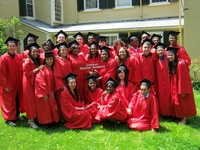
After spending three summers taking courses at Harvard, Crimson Summer Academy scholars graduate each year at Harvard's Commencement.
(Part I and Part III of this story appeared on May 7 and May 11, 2012.)
Students headed to summer school most likely imagine long days in stuffy classrooms filled with their least favorite academic subjects instead of their favorite summertime activities.
Most students probably do not envision the lush trees and historic red brick buildings of Cambridge. Nor do they expect top teachers culled from schools across the country, creative projects rather than remedial reviews, and other cutting-edge educational methods designed to generate enthusiasm among students.
Yet this is what happens when Harvard resources meet public summer schools.
The University supports two summer programs catered to Cambridge high school students. The first, Crimson Summer Academy, brings approximately 90 high-achieving, economically disadvantaged students from Boston and Cambridge to live in Harvard dorms and take rigorous classes for six weeks each summer. Students pass through a highly selective admission process to win a spot in the three-year CSA program.
Just a few blocks down Broadway, more than 300 high school students prepare for the coming school year at the University-funded Cambridge-Harvard Summer Academy, Cambridge’s sole high school summer school and a joint project of Cambridge Rindge and Latin School and the Harvard Graduate School of Education’s Teacher Education Program.
CSA and CHSA, both funded by the University President’s Office, have garnered much attention since they were established in 2004 and 2001, respectively. Through these innovative programs, the University and the community help students to excel long after the summer ends.
CLOSING THE GAP
Waking up in his dorm room in Weld from a nap after his morning statistics class, Regal Sealy glanced at his clock to discover that he was an hour and a half late to his expository writing class.
Frantically, Sealy packed his backpack, ran through the Yard, rushed past Annenberg, and slowed as he entered CGIS.
He apologized to his instructor, who told him not to worry.
“It was a little different, the amount of time you [had] between classes,” Sealy says.
Sealy, the child of immigrants from Panama and Barbados, is a senior at the Academy of the Pacific Rim in Boston, and for the past three years he has attended CSA in hopes of becoming the first person in his family to go to college.
CSA students, known as Crimson scholars, spend weekdays in the summer taking classes and participating in activities on Harvard’s campus. The highly selective free program draws many students from Cambridge public schools—many of whom had spent time on the federal Department of Education’s watch list due to poor standardized test scores.
The program accepts about 30 students each year, with an average family income of $28,000, according to CSA Director Maxine Rodburg.
Read more in News
New Book by HBS Professor Advocates for Downtime













